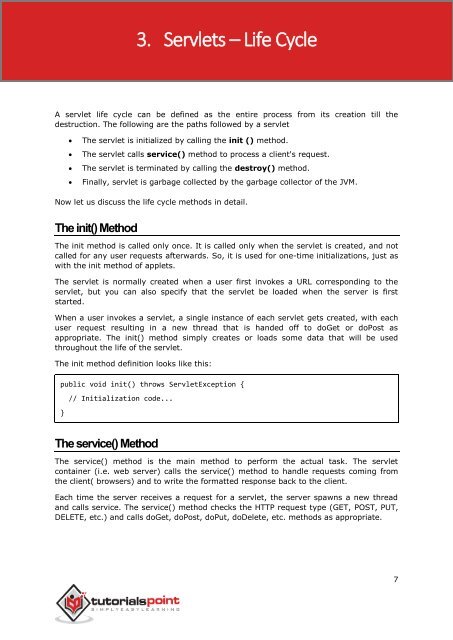You also want an ePaper? Increase the reach of your titles
YUMPU automatically turns print PDFs into web optimized ePapers that Google loves.
3. Servlets – Life Cycle<br />
Java Servlets<br />
A servlet life cycle can be defined as the entire process from its creation till the<br />
destruction. The following are the paths followed by a servlet<br />
<br />
<br />
<br />
<br />
The servlet is initialized by calling the init () method.<br />
The servlet calls service() method to process a client's request.<br />
The servlet is terminated by calling the destroy() method.<br />
Finally, servlet is garbage collected by the garbage collector of the JVM.<br />
Now let us discuss the life cycle methods in detail.<br />
The init() Method<br />
The init method is called only once. It is called only when the servlet is created, and not<br />
called for any user requests afterwards. So, it is used for one-time initializations, just as<br />
with the init method of applets.<br />
The servlet is normally created when a user first invokes a URL corresponding to the<br />
servlet, but you can also specify that the servlet be loaded when the server is first<br />
started.<br />
When a user invokes a servlet, a single instance of each servlet gets created, with each<br />
user request resulting in a new thread that is handed off to doGet or doPost as<br />
appropriate. The init() method simply creates or loads some data that will be used<br />
throughout the life of the servlet.<br />
The init method definition looks like this:<br />
public void init() throws ServletException {<br />
}<br />
// Initialization code...<br />
The service() Method<br />
The service() method is the main method to perform the actual task. The servlet<br />
container (i.e. web server) calls the service() method to handle requests coming from<br />
the client( browsers) and to write the formatted response back to the client.<br />
Each time the server receives a request for a servlet, the server spawns a new thread<br />
and calls service. The service() method checks the HTTP request type (GET, POST, PUT,<br />
DELETE, etc.) and calls doGet, doPost, doPut, doDelete, etc. methods as appropriate.<br />
7


